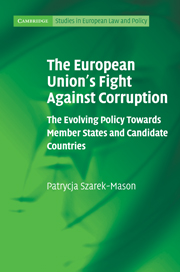 The European Union's Fight Against Corruption
The European Union's Fight Against Corruption Book contents
- Frontmatter
- Contents
- Table of cases
- Acronyms and abbreviations
- List of tables and figures
- Introduction
- 1 Corruption: concept, importance and international response
- 2 The scope of EU legal powers and development of the policy in the area of anti-corruption
- 3 The EU strategy against corruption within the Member States
- 4 Conditionality in the EU accession process
- 5 The EU's evaluation of corruption in the Central and Eastern European candidate countries
- 6 The EU anti-corruption strategy towards the Central and Eastern European candidate countries: achievement or missed opportunity?
- 7 The impact of 2004 enlargement on the EU anti-corruption policy
- 8 Conclusion
- List of interviews and consultations
- Appendix 1
- Appendix 2
- Bibliography
- Index
- CAMBRIDGE STUDIES IN EUROPEAN LAW AND POLICY
8 - Conclusion
Published online by Cambridge University Press: 03 May 2010
- Frontmatter
- Contents
- Table of cases
- Acronyms and abbreviations
- List of tables and figures
- Introduction
- 1 Corruption: concept, importance and international response
- 2 The scope of EU legal powers and development of the policy in the area of anti-corruption
- 3 The EU strategy against corruption within the Member States
- 4 Conditionality in the EU accession process
- 5 The EU's evaluation of corruption in the Central and Eastern European candidate countries
- 6 The EU anti-corruption strategy towards the Central and Eastern European candidate countries: achievement or missed opportunity?
- 7 The impact of 2004 enlargement on the EU anti-corruption policy
- 8 Conclusion
- List of interviews and consultations
- Appendix 1
- Appendix 2
- Bibliography
- Index
- CAMBRIDGE STUDIES IN EUROPEAN LAW AND POLICY
Summary
The EU successfully supported and reinforced political and economic reforms in the accession states in Central and Eastern Europe. The incentive of membership benefits combined with strong conditionality gave the EU the necessary leverage to promote anti-corruption reforms in candidate countries. The post-communist countries had to meet vast anti-corruption requirements and were subject to an intrusive evaluation mechanism. Significant improvements were made, but it was far from a complete process. Corruption is an ongoing challenge and combating it requires a long-term and consistent commitment. The EU has been able to use the accession process to commit the CEE countries’ national governments to anti-corruption reforms, but this ability ceased to exist on the day of accession. If the irreversibility of anti-corruption reforms is not ensured, there is a danger that the quality of democratic changes in these countries could be seriously undermined.
The need for a more coherent anti-corruption policy became particularly urgent with the accession of Romania and Bulgaria in 2007. The recourse to a post-accession verification mechanism only demonstrated that the EU was unable to respond to the problem of corruption within the countries once they gained Member State status. It also showed that the EU recognises that current pre-accession policy is not robust enough to cure problems with corruption in the candidate countries.
As a result of the 2004 enlargement, corruption became one of the priorities in EU external policy. The EU reinforced its anti-corruption strategy towards the candidate and potential candidate countries.
- Type
- Chapter
- Information
- The European Union's Fight Against CorruptionThe Evolving Policy Towards Member States and Candidate Countries, pp. 265 - 269Publisher: Cambridge University PressPrint publication year: 2010
